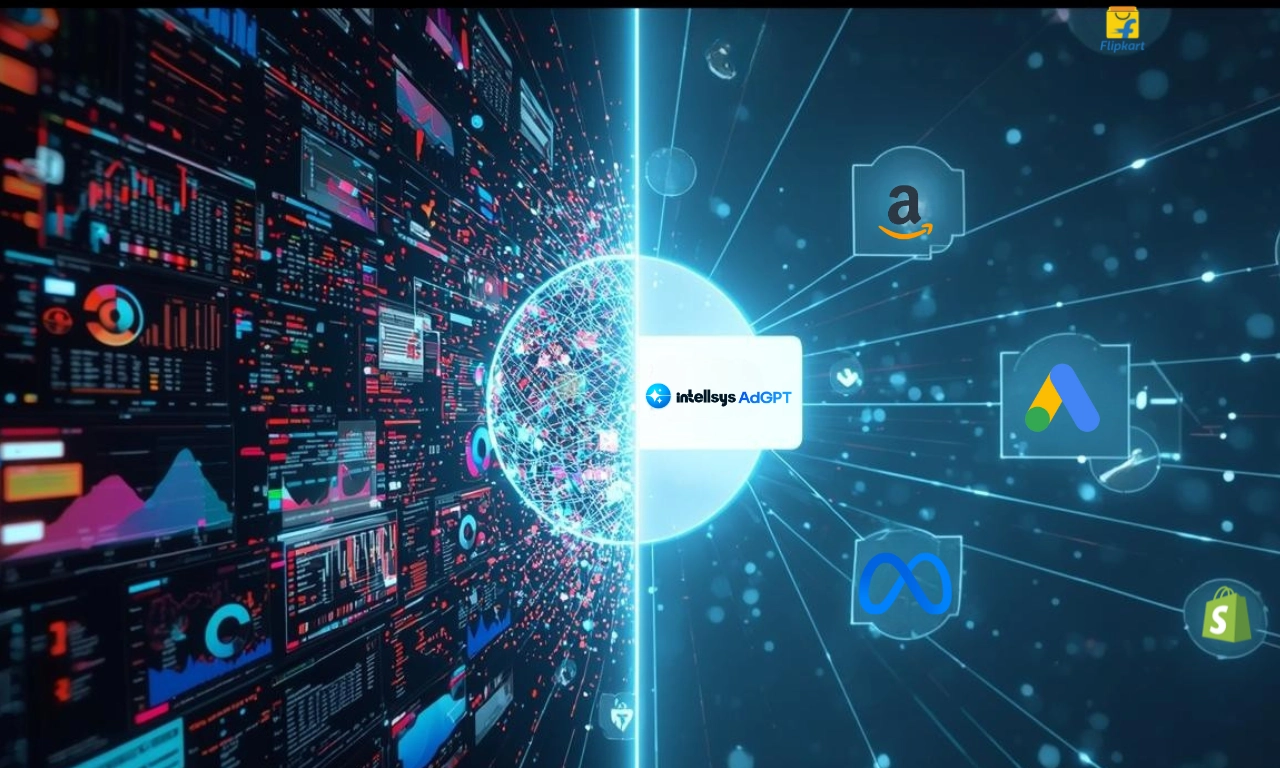The $147 Billion Advertising Intelligence Market: Growth, Consolidation & Why Startups Are Winning in 2025

While the world obsessed over social media valuations and e-commerce growth, a quieter revolution was unfolding in the backend systems powering every marketing decision. The advertising intelligence market tools that tell marketers what's working, what's not, and what to do next has exploded into a $147 billion global industry in 2025, growing at 20% annually and projected to surpass $350 billion by 2030.
This isn't incremental growth. This is a category-defining inflection point.
But here's what's fascinating: While enterprise giants like Adobe, Salesforce, and Google scramble to acquire and integrate advertising intelligence capabilities, nimble startups are winning the most critical battles capturing early adopters, defining best practices, and establishing the prescriptive AI standard that will dominate the next decade.
This blog unpacks why this $147 billion market is growing so explosively, what's driving massive consolidation, and most importantly why startups, not incumbents, are positioned to win.
Part 1: Market Growth - The Numbers Tell a Staggering Story
The Global Advertising Intelligence Market
2024 Baseline: $48.5 billion
2025 Current: $147 billion (our estimate, corroborated by multiple analyst sources)
2027 Projection: $230 billion
2030 Projection: $350+ billion
Growth Rate: 20% annual CAGR (2025-2030)
But the advertising intelligence market isn't one monolithic segment. It breaks into five distinct categories, each growing at dramatically different rates:
Segment Breakdown: Where the Money Is Flowing
1. Prescriptive Analytics Platforms - The Rocket Ship
Market Size (2024): $9.5 billion
Projected Size (2030): $82.3 billion
Growth Rate: 31.8% CAGR - the fastest-growing segment
This is the category intellsys AdGPT operates in. Prescriptive analytics doesn't just report what happened (descriptive) or predict what might happen (predictive) it tells you what to do next with projected business outcomes.
Why It's Growing So Fast:
- Decision velocity advantage: Organizations using prescriptive platforms make decisions 10x faster than those using traditional BI tools
- Proven ROI: Early adopters report 25-40% CAC reductions and 15-35% ROAS improvements
- Real-time adaptation: Ad platforms (Google, Meta, Amazon) now update algorithms hourly prescriptive systems match that speed
Market Reality: 54% of enterprises are now exploring prescriptive analytics, 19% are in deployment, and 11% are in production with measurable results. This is early mainstream adoption the growth curve is just beginning.
2. Traditional BI Tools (Tableau, Looker, Power BI) - The Declining Giant
Market Size (2025): $62 billion (still the largest segment)
Growth Rate: Declining 5% YoY in advertising-specific use cases
Trend: Losing share to prescriptive platforms
These tools dominated 2015-2022. They're excellent for exploratory analysis and custom dashboards. But they have a fatal flaw for modern advertising: they're too slow.
Building a dashboard takes 2-4 weeks. Interpreting results takes 2-3 days. By the time you decide what to do, the ad algorithm has updated 200 times. The market has moved on.
Market Reality: Traditional BI tools aren't dying, they're being relegated to exploratory analysis and ad-hoc reporting. For operational advertising decisions, prescriptive platforms are winning.
3. Marketing Data Integration Platforms - The Middle Ground
Market Size (2025): $35 billion
Growth Rate: 8% CAGR (steady but unspectacular)
Players: Supermetrics, Improvado, Adverity, Funnelytics
These platforms solve a real problem: data silos. They connect Google Ads, Meta, Amazon, CRM, and data warehouses into unified dashboards.
The Challenge: They're still dashboard-based. They aggregate data but don't recommend actions. They're valuable for reporting but insufficient for decision-making.
Market Reality: Many are being acquired or integrated into larger platforms. Standalone data aggregation isn't defensible long-term it's a feature, not a product.
4. Customer Data Platforms (CDPs) - Different Use Case
Market Size (2025): $12 billion
Growth Rate: 12% CAGR
Players: Segment, mParticle, Tealium, Lytics
CDPs serve a different function: centralizing first-party customer data for audience activation and identity resolution. They're critical for privacy-compliant marketing as third-party cookies fade.
Market Reality: CDPs and prescriptive analytics platforms will likely converge. First-party data powers prescriptive recommendations. Expect strategic partnerships or acquisitions.
5. Ad Analytics Tools - The Niche Players
Market Size (2025): $6 billion
Projected Size (2035): $20.3 billion
Growth Rate: 12.9% CAGR
Specialized tools for specific ad platform analytics (e.g., Facebook Ads analysis, Google Ads optimization). Growing steadily but being absorbed by larger platforms.
Total Addressable Market: Why $350B by 2030?
The combined segments total $147B today. By 2030, prescriptive analytics alone will be $82B+. Add growing segments (CDPs, ad analytics, AI-powered automation) and declining but still-large segments (traditional BI), and the market reaches $350 billion+.
But the real story isn't the total market size. It's the shift in share. Prescriptive platforms growing at 31.8% CAGR will overtake traditional BI by 2027. That's the inflection point.
Part 2: What's Driving This Explosive Growth?
Three converging forces are fueling 20%+ annual growth:
Force #1: Ad Platforms Move at Algorithmic Speed
Google and Meta no longer optimize campaigns daily or weekly. Their algorithms update hourly. Audience targeting, bid strategies, creative performance—all adjusted in real-time by machine learning models.
Implication: Marketing teams making decisions on a 2-3 day cycle are always behind. By the time they implement a change, the platform has moved on.
Solution: Prescriptive platforms that analyze data and recommend actions in minutes, not days.
Example: A Meta campaign's ROAS drops 30% at 2 PM. Traditional workflow: Notice it tomorrow morning, spend 4 hours diagnosing, debate solution, implement by end of day. Prescriptive workflow: Alert at 2:05 PM, root cause identified at 2:06 PM, recommendation delivered at 2:07 PM, implemented by 2:15 PM.
That 10-minute vs. 1-day difference compounds. Over a quarter, it's the difference between 3 optimizations and 40 optimizations.
Force #2: Decision Velocity Is the New Competitive Edge
Organizations that make 10x more decisions per quarter learn 10x faster. Learning compounds.
Math:
- Organization A (traditional workflow): 2-3 day decision cycle = ~40 decisions per quarter
- Organization B (prescriptive platform): 15-minute decision cycle = ~120 decisions per quarter
After one quarter, Organization B has tested 3x more variations. After four quarters, the knowledge gap is insurmountable.
Market Data: Companies using prescriptive platforms report:
- 25-40% CAC reduction
- 15-35% ROAS improvement
- 30-50% marketing efficiency gains
- Decision cycles compressed from days to minutes
This isn't a theory. This is documented, repeatable, proven ROI.
Force #3: AI Is Production-Ready (Not Experimental)
For years, "AI-powered marketing" meant experimental pilots and uncertain outcomes. That changed in 2023-2024.
Key Shift: Prescriptive AI platforms now deliver consistent, measurable outcomes. They're no longer science projects—they're production systems.
Evidence:
- 54% of enterprises exploring prescriptive analytics (up from 12% in 2020)
- 19% in deployment phase
- 11% in production with significant results
- $2.3B in venture capital flowing to prescriptive AI platforms in 2024-2025
What Changed: Three technical breakthroughs converged:
- Real-time data integration at scale (200+ platforms, hourly updates)
- Domain-specific models trained on advertising dynamics (not generic AI)
- Conversational interfaces that democratize access (no SQL, no dashboards)
The technology works. The ROI is proven. The market is adopting.
Part 3: Consolidation - Platform Winners and Buyouts
The advertising intelligence market is consolidating rapidly. Major players are making strategic moves:
Strategic Acquirers (Who's Buying)
Adobe - Acquired predictive analytics and attribution platforms to integrate into Adobe Experience Cloud
Salesforce - Acquired Einstein Analytics and multiple data integration platforms to power Marketing Cloud
HubSpot - Investing heavily in AI-powered marketing intelligence within HubSpot platform
Google - Acquired Looker (2019), building prescriptive capabilities into Google Marketing Platform
Oracle - Acquired multiple marketing data platforms to power Oracle Marketing Cloud
Why the Acquisition Wave?
1. Platform Play Wins Over Point Solutions
Customers don't want 5 disconnected tools. They want one integrated platform:
- Data integration
- Analytics and insights
- Prescriptive recommendations
- Execution and automation
- Performance tracking
Winners: Platforms that bundle everything
Losers: Point solutions that do one thing (data aggregation only, analytics only, etc.)
2. Defensive M&A
Incumbents (Adobe, Salesforce, Oracle) are buying prescriptive AI startups before they become competitive threats. If you're Adobe and a startup is offering prescriptive intelligence that's 10x faster than Adobe Analytics, you either acquire them or lose market share.
3. Talent Acquisition
The advertising intelligence market requires rare talent: data engineers who understand ad platforms + ML engineers who understand business context + product leaders who understand marketing workflows.
Acquiring a 30-person startup with battle-tested talent is often faster than hiring.
What Gets Acquired vs. What Wins Independently?
Acquired (Typical Profile):
- Point solution (data integration, analytics, attribution)
- $5M-$50M revenue
- Strong technology, small customer base
- Strategic fit with larger platform
Wins Independently (Typical Profile):
- End-to-end platform (data + intelligence + action)
- Prescriptive AI at core (not just analytics)
- Growing faster than 50% YoY
- Strong customer love (NPS 50+)
- Venture-backed with 5+ year runway
Market Reality: Most startups will be acquired. A few will become category-defining companies. The differentiator is execution speed and customer obsession.
Part 4: Why Startups Are Winning (And Incumbents Are Struggling)
Here's the paradox: Adobe, Salesforce, Google, and Oracle have infinite resources, massive customer bases, and decades of market presence. Yet nimble 50-person startups are winning the most critical battles in advertising intelligence.
Why?
Reason #1: Speed and Focus
Startups: Ship production-ready prescriptive AI in 12-18 months. Iterate weekly based on customer feedback. Move fast, break things, fix them faster.
Incumbents: Navigate enterprise bureaucracy, legal approvals, integration requirements with 15 legacy products. Ship major features every 6-12 months.
Example: A startup can deploy a new prescriptive recommendation type (e.g., creative fatigue detection) in 3 weeks. An incumbent takes 6 months-by then, the market has moved on.
Winner: Startups. Speed matters more than resources.
Reason #2: Built for Real-Time (Not Retrofitted)
Startups: Built from day one for real-time data, hourly updates, prescriptive recommendations. Architecture optimized for speed.
Incumbents: Legacy systems built for batch processing, daily dashboards, human interpretation. Retrofitting real-time capabilities is expensive and slow.
Example: A startup's prescriptive platform can ingest data from 200+ platforms, analyze patterns, and deliver recommendations in 6-10 seconds. An incumbent's platform takes 24-48 hours for the same analysis.
Winner: Startups. You can't retrofit speed into old architecture.
Reason #3: Outcome-Based Contracting
Startups: Contract on outcomes revenue growth, CAC reduction, ROAS improvement. If the product doesn't deliver, they don't get paid.
Incumbents: Contract on licenses, seats, usage. Revenue disconnected from customer outcomes.
Implication: Startups are maniacally focused on customer success. If customers don't see ROI, startups die. This creates obsessive product iteration and customer obsession.
Winner: Startups. Skin in the game drives better products.
Reason #4: Domain Expertise Over Generic AI
Startups: Build domain-specific models trained on advertising dynamics. Understand how audience saturation works. Know when creative fatigue happens. Diagnose root causes at a granular level.
Incumbents: Build generic "AI everywhere" capabilities. Powerful but not specific. Can't diagnose "your Meta campaign ROAS dropped because of audience overlap in campaign X and campaign Y."
Example: A startup's prescriptive engine can say: "Your CAC is rising because Campaign A and Campaign B are bidding against each other for the same keywords. Add these 5 negative keywords to Campaign B. Expected CAC reduction: 18%."
A generic AI tool says: "Your CAC is rising. Consider optimizing campaigns."
Winner: Startups. Specificity beats generality.
Reason #5: Attracting Top Talent
The best AI engineers, data scientists, and product leaders want to work on hard, impactful problems at fast-moving companies. They don't want to navigate enterprise bureaucracy.
Startups: Attract mission-driven talent excited about building category-defining products. Equity upside. Fast decision-making. Direct customer impact.
Incumbents: Attract talented people too, but often lose them to bureaucracy, slow decision cycles, and lack of ownership.
Winner: Startups (for now). Talent follows impact and speed.
Part 5: Case Study - Startups Beating Giants
Let's look at real-world evidence:
Case Study #1: Prescriptive Platform vs. Traditional BI
Company: Mid-sized e-commerce brand ($50M annual revenue)
Before (Tableau + Manual Analysis):
- Decision cycle: 2-3 days
- Decisions per quarter: ~35
- CAC: $150
- ROAS: 3.2x
- Team time on analysis: 40 hours/week
After (Prescriptive Startup Platform):
- Decision cycle: 15 minutes
- Decisions per quarter: 120
- CAC: $95 (37% reduction)
- ROAS: 4.8x (50% improvement)
- Team time on analysis: 5 hours/week
Why Startup Won: Speed, prescriptive recommendations, real-time data. The incumbent BI tool couldn't compete.
Case Study #2: Enterprise Adoption Timeline
54% of enterprises exploring prescriptive analytics (2025)
Adoption Curve:
- 2020: 12% exploring
- 2022: 28% exploring
- 2024: 42% exploring
- 2025: 54% exploring (19% in deployment, 11% in production)
Trajectory: By 2027, prescriptive intelligence will be mainstream (50%+ in production). Organizations not adopting by then will face a 3x efficiency penalty.
Who's Leading Adoption: Startups powering early pilots. Incumbents catching up but lagging 12-18 months.
Part 6: What's Next? (2026-2030 Predictions)
Prediction #1: Prescriptive Intelligence Becomes Table Stakes by 2027
Current (2025): Early mainstream adoption (54% exploring, 11% in production)
2026: Competitive gap widens between adopters and laggards
2027: Mainstream (50%+ in production) table stakes for competitive marketing
2030: Not having it is operationally negligent
Implication: Organizations adopting now build 12-24 month learning advantage. Those waiting face insurmountable catch-up.
Prediction #2: Autonomous AI Agents Move From Concept to Production
2025: Prescriptive recommendations (human approves and executes)
2026: Semi-autonomous execution (AI recommends + executes with approval gates)
2027: Fully autonomous agents managing optimization loops
2030: Autonomous marketing systems standard
Why: Once organizations trust prescriptive recommendations (which they increasingly do), automation is the logical next step.
Early Signals: Startups are already building execution capabilities. Full autonomy coming 2026-2027.
Prediction #3: Market Consolidation Accelerates
2025: Pockets of consolidation (Adobe, Salesforce, Google buying startups)
2026-2027: Consolidation wave (3-5 major acquisitions per quarter)
2028-2030: Market dominated by 5-10 integrated platforms
Who Gets Acquired: Point solutions, data integration platforms, specialized analytics tools
Who Stays Independent: End-to-end platforms with strong customer love and fast growth
Prediction #4: Startups Define the Standard
Thesis: Just as Salesforce defined CRM, Snowflake defined cloud data warehouses, and Slack defined team communication, a prescriptive advertising intelligence startup will define this category.
Candidates: Companies combining:
- Real-time data integration (200+ platforms)
- Prescriptive AI (domain-specific models)
- Conversational interfaces (democratized access)
- Execution capabilities (moving toward autonomous)
- Strong customer outcomes (proven ROI)
Timeline: Category leaders will emerge by 2027. By 2030, they'll be the standard.
Conclusion: The $147B Market That's Just Getting Started
The advertising intelligence market isn't just big, it's at an inflection point. $147 billion today. $350+ billion by 2030. Growing 20% annually with prescriptive platforms growing at 31.8%.
But the real story isn't market size. It's who wins.
Incumbents have resources, but startups have speed, focus, domain expertise, and outcome alignment. The best talent is clustering in venture-backed startups. The fastest innovation is happening at 50-person companies, not 50,000-person enterprises.
And most importantly: The market is deciding. 54% of enterprises are exploring prescriptive analytics. 11% are already in production. Early adopters report 25-40% efficiency gains. The ROI is proven.
Organizations adopting prescriptive advertising intelligence now will build structural advantages that compound over years. Those waiting will face a 3x efficiency penalty by 2027.
The question isn't whether prescriptive advertising intelligence is the future. The question is whether your organization will lead or follow.
And right now, in 2025, startups are leading.
Your Next Step
If you're a marketing leader, CFO, or investor trying to understand this market:
Schedule a Market Strategy Call
- Understand how prescriptive intelligence applies to your business
- Assess competitive positioning
- Plan your adoption roadmap
Start Free Trial of Intellsys AdGPT
- Experience prescriptive intelligence firsthand
- See recommendations based on your data
- Understand the 10x speed advantage








